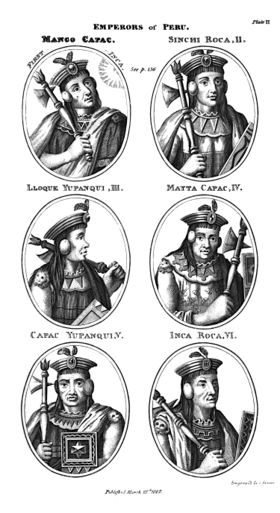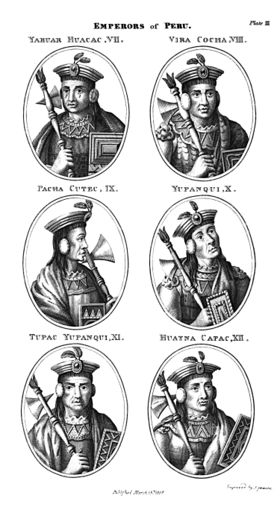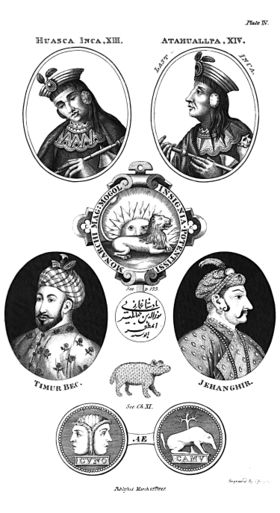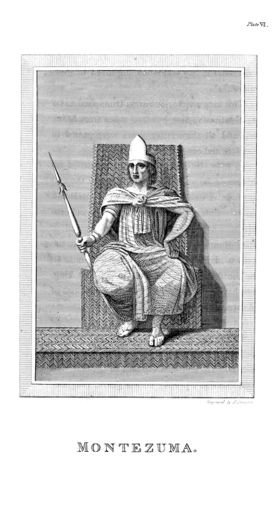The Conquest of Peru, Mexico, Bogota, Natchez, and Talomeco, in the Thirteenth Century by the Mongols (1827 book)
From Kook Science
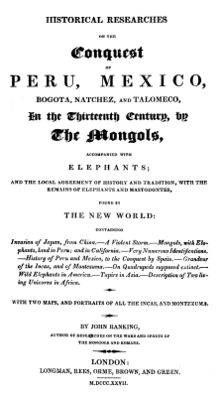 | |
| Author | John Ranking |
|---|---|
| Publisher | Longman & Co. |
| Location | Lynchburg |
| Pub. date | 1827 |
| Language | English |
| Subject | Conquest of the Americas by Mongols (and their Elephants) |
Historical Researches on the Conquest of Peru, Mexico, Bogota, Natchez, and Talomeco, in the Thirteenth Century by the Mongols, Accompanied With Elephants: and the Local Agreement of History and Tradition, With the Remains of Elephants and Mastodontes, Found in the New World is a non-fiction book by amateur historian John Ranking, first published in 1827 by Longman & Co. (for the author), in which the author proposes that the Kublai Khan's naval fleet, sent to invade Japan, was carried across the Pacific and landed in South America, which they subsequently conquered and established as the Inca Empire under the rulership of the Kublai Khan's son, who became known as Manco Cápac, later expanding north to form the Aztec Empire of Mexico, and that this same Mongol fleet had brought elephants with them into the New World.
Text
- Ranking, John (1827), Historical Researches on the Conquest of Peru, Mexico, Bogota, Natchez, and Talomeco, in the Thirteenth Century by the Mongols, Accompanied With Elephants: and the Local Agreement of History and Tradition, With the Remains of Elephants and Mastodontes, Found in the New World, London: Longman & Co., https://archive.org/details/historicalresear00rank
Contemporary Reviews
(From a combined review of Ranking's 1926 book Historical Researches on the Wars and Sports of the Mongols and Romans; in Which Elephants and Wild Beasts Were Employed or Slain, and the 1927 book Conquest of Peru, et. al., by the Mongols).
Of all these annals of Mongol conquest, Mr. R. has collected, from very many, and often new sources, a large amount of interesting particulars; his own immediate object, however, being to bring into view, the vast numbers of elephants which, as he always assumes, and in many instances proves, accompanied the armies of the Mongols; and throughout this part of his inquiry into Mongol history, comprehended within the first of his two works, historical data, rather than historical conjecture, occupy his pages. It belongs, however, to the history of Cublai Khan, who, after his acquisition of the throne of China, became known, in that country, by a Chinese name, to add, that, not satisfied with that great conquest, he had scarcely achieved it, before, confiding the expedition to his commanders, he attempted the invasion and conquest of the Japan islands also. That expedition, of which the unfortunate issue is variously related, has supplied to Mr. R. the basis of a conjecture, in reliance upon which he boldly assumes, that the Mongol fleet crossed the Pacific Ocean — was laden with elephants — and, arrived upon the western coast of America, conquered the nations, and established the empires of Mexico and Peru, — to be reconquered, a little more than two centuries afterward, by the Spaniards from Europe. But, from all this latter part of Mr. R.'s historical and military conclusions, we are obliged to withhold any share of our consent; and of the haste with which our author imagines identities between the Mexicans and Peruvians and the Mongols, our subjoined remarks, while they illustrate some facts connected with real Asiatic warfare, will furnish an example that, a part being taken for the whole, must constitute some apology for our scepticism!
Mr. Ranking is exceedingly misled, where (Conquest of Peru, p. 354,) he thinks himself justified in resembling the pyramidic places of worship of the Mexicans, to the "pyramids" of Baber and Timur, of which, nevertheless, he cites particular descriptions: — "The Mogul Emperor, Baber, (Dow's History of Hindostan,) immediately after his celebrated victory, A. D. 1526, assumed the title of Ghazi; and, as a monument to perpetuate the memory of the battle, he ordered a pyramid to be built upon an eminence near the field, which, according to the custom of his age and nation, was stuck round with the heads of the slain." — "Timur," adds Mr. R., on the authority of Sherefeddin, "erected one hundred and twenty towers or pyramids, of ninety thousand skulls, at Bagdat." — "The Mongols of Asia," remarks Mr. R., meaning to distinguish those Mongols, from his own Mongols of America, "although Mahommedans, continued to build such structures, to awe and terrify their enemies." For our part, we think, Mr. Dow's account of the motive for building those "pyramids," or "towers," something nearer the truth than Mr. R.'s; that is, we believe that they were built, not to "awe and terrify," but as trophies, or exhibitions of spoil, or monuments of victory and triumph at home; and are to be compared, as to their motive, only with the triumphal arches and columns or pillars of more refined, though warlike nations. In reality, so little need is there for qualifying the rude, barbarous exhibitions of Baber, or even Timur, by any reference to the age or nation of either, or to make any exception in favour of Mahommedans, that the Persians of this day and hour are followers of a similar practice; but, then, neither "pyramid," nor "tower," is the fit name for the structures raised! The latest of our English travellers in Persia (Mr. Alexander) beheld, upon an eminence, overlooking a river near the fort of Ardebeel, (lately constructed by Major Monteith, of the Madras Engineers, surveyor general in Persia,) and at the foot of Mount Sevelund, no fewer than five of these structures, decorated with the heads of a thousand Russians, whom the Persian troops have slain in the pending war with the northern potentate, and the figures of which structures present themselves in that gentleman's drawing of them and the surrounding landscape. From the recollection of the print in his work, it had occurred to us, in reference to the mistake of Mr. R., that they might more fitly be termed obelisks than "pyramids;" but, upon recurring to Mr. Alexander's pages, we find that they are there denominated "pillars," and are called by the Persians themselves, "Kellah-i-Minar," or "Pillars of Heads:" — "About a mile and a half from the camp," says Mr. A., "was a singular monument of barbarity. On a small hill on the plain were erected five Kellah-i-Minar, or Pillars of Heads. The Pillars were built of brick and lime; and into niches were thrust the heads of about one thousand Russians, which had been sent to the royal camp; they had been all pickled, and were placed round the Pillars in rows. A more disgusting sight can hardly be imagined: into the mouths of one of the heads a pipe had been insultingly stuck. The price of Russian heads at this time was five tomauns. The custom of making a pyramid of the heads of enemies has existed in Persia from time immemorial."[*1] After these illustrations of the subject in hand, will it not appear reasonable to conclude, that when Duhalde, as quoted by Mr. R., talks of "two pyramids in ruins," among the remains of the ancient Tartar city of Para-Hotun, it is the ruins of "pillars," or of obelisks, whether of heads or otherwise, to which he refers? Mr. R. laments that the learned Jesuit has omitted to mention the size of the "pyramids," and we may equally lament that we do not know the size of Timur's "pyramids" or " towers" of skulls at Bagdat, those of Baber of the year 1526, and those of Ardebeel of 1826; but that any of these Tartar or Scythian Kellah-i-Minar, built as trophies of victory have borne, at any time, or in any place, the slightest resemblance, either in size, figure, or destination, to the pyramidal places of divine worship in Teotihuacan, Choluba, or Papantla, in Mexico, is what we may with very tolerable safety most explicitly deny! Some share of precise information, we see, is gained by the accident of a drawing of the Kellah-i-Minar having been made by Mr. Alexander; and we have here one of the endless examples of the superior precision of knowledge, concerning all visible objects, to be conveyed by drawings, in preference to written representations! On the whole, and though with deference to the opinion too hastily taken up by Mr. R., we shall run no risk in affirming, that the inquiry affords an instance of the failure to establish an identity between the Mexicans and Mongols. It certainly has never happened, that the Mongols raised structures in any one particular resembling the religious pyramids of the Mexicans; and, upon the other hand, it is equally certain, that we have no reason to believe, that any thing like the Kellah-i-Minar of the Asiatic barbarians, has ever raised its head in any part of America!
All nations, in the meantime, while in a state of greater or less barbarism, have made some display or other of the bodies, or parts of the bodies, of their slaughtered enemies. To leave the bodies, in an entire state, upon the field of battle, is to bear away no ocular proof of the numbers of the slain. Heads and skulls, though of less bulky carriage, and more easily counted, are still a burdensome trophy. The Mexicans did not, like the Mongols and Persians, bear away the heads of the fallen (for they had neither Scythian waggons, nor even beasts of burden, unless we concede their elephants!) for the purpose; but, in ages prior to the fifteenth century, or to the arrival of the Spaniards, they did (Conquest, &c.) that which the Turks of Constantinople still do in the nineteenth; — they brought away the ears only, wisely contenting their unassisted hands with this lighter load, and wisely reflecting that every two ears stood for one enemy killed, almost as surely as one head! But the Americans, or American Indians, generally, have still further improved upon this method of diminishing the fatigues of the victor, and, at the same time, of increasing the durability of the trophy; that is, they have taken from the dead warrior (often, in their haste, they take it while he is still living !) nothing more than the scalp, or skin of the fore part of the head, with its pendent hair; a tolerable document of destruction, when won from enemies who wear long hair, but one that is not so eligible among Tartars, who shave the head close. Scalps, indeed, would afford but indifferent trophies of a public kind, where a mighty prince desires to accumulate the bloody spoils of his whole army, to signalise the assembled glory of himself and of his people (that people building with stone or brick), and to exhibit them, bare to weather, upon the tops of hills, for the admiration of the traveller; but dried scalps, the pride of single warriors, or of small communities, curiously ornamented with coloured shell-work, or porcupine quill, or cotton, the pride of the domestic tent or wigwam, or the occasional display of the common council-house, is a far more portable, and equally honourable testimonial! From national circumstances like these, originate the various modes of pursuing one similar purpose; and, if it be true, that among the Calmuc Tartars, and among the Calmuc Tartars alone, throughout the ancient continent, the practice of carrying away the scalps of the slain subsists, or has ever subsisted, in the manner still practised in America, that fact will establish, that the Calmuc Tartars alone, of all the nations of the ancient continent, bear, or have borne, in their condition and modes of life, a close resemblance to the nations of America. It deserves, however, to be recollected, that we hear nothing of the practice of scalping, in any history either of Mexico or Peru; that in Mexico we hear of the substitute, and, perhaps, we should say more civilized, because public substitute, of taking the ears of the slaughtered; that the use of scalping is not in use but by the more eastern nations of America; a fact, at the same time, which may justify our inquiry, with some expression of surprise, whether neither Mexicans nor Peruvians, giving way to the imitative nature of man, ever adopted such a practice from their neighbours; an act of imitation which even the descendants of Europeans, in the nineteenth century, have not wholly abstained from, as was seen in the example of the soldiers of the United States of North America, in their war with Great Britain of the year 1811?
But again, as to there being any thing peculiar to the Mongols, even in their building into pillars of brick or stone the skulls or pickled heads of their slaughtered enemies; the simple truth is, that all the nations of the world do, or have done, something more or less resembling this, in one period or other of their history. The Turkish commanders still pay money to their troops for the ears which they are able to bring in, in sacks, from the scene of slaughter; the Turkish Sultan still exhibits the heads and limbs of rebels upon the walls of the Seraglio; the negro monarchs of Africa still make the skulls of their enemies the permanent architectural ornaments and friezes of the clay walls of their royal abodes; England, till within a very recent date, stuck the heads and quarters of rebels and traitors, if not of foreign enemies, upon the gates of her cities and castles; and even "pickled," like Persians of this day, the mutilated flesh of the men whose remains she thus disposed of![*2] It is by the suggestion of examples like these, that we seek to warn such as engage in historical researches from treating as peculiar to men of some nations, that which is or has been common to many, and which therefore identifies that nation or nations, not with any one, or other limited number beside, but only with mankind at large! The practices of nations do and must correspond with their physical circumstances and moral condition; and, as a general rule, all men, in the same circumstances, do the same things. But there is still another source of historical mistake; that of falsely imagining a resemblance between things which are really dissimilar.
*1: Alexander's Travels from India to England, 4to. London. 1827, p. 191. See New London Literary Gazette, Nos. 1 & 2.
*2: To afford an unquestionable demonstration to the multitude, that a national event has really taken place, is another of the least questionable of the motives for exhibitions thus barbarous, among the usages of barbarous nations. In proportion as a people are rude, and without the use of letters, and without that wide communication which is formed in highly civilized states, it is often difficult for governments to satisfy them of the certainty of an event which may be of the last importance to the peace and happiness of a country. In France, there are many who still dispute the fact of the death of Buonaparte. In Portugal, Dom Sebastian is popularly believed to be still living. In England, in the year 1402, Henry IV. made use of this last resort, for convincing the people that Harry Percy was no more. At the "sory bataill of Schroves- bury, that is to saye, between King Henry and Sir Heary Percy, sone of the erle of Northumberland, the which Sir Henry Percy was there sclayn and there beryed;" "forasmoche as some peple seyde that Sir Henry Percy was alyve, he was taken up agen out of his grave, and bounden upright between to mille stones, that alle men might se that he was ded." — Chronicle of London, 4to. 1827, p. 88.
